An Update on the Cosmetic Use of Botulinum Toxin: The Pattern of Practice among Korean Dermatologists
Abstract
:1. Introduction
2. Materials and Methods
3. Results
3.1. What Is Your Practice Setting?
3.2. How Long Have You been Practicing Botulinum Toxin Injections?
3.3. What Is the Approximate Percentage of Patients Who Visit Your Office for Cosmetic Procedures and for Disease Treatment?
3.4. What Is the Patient Proportion, by Age (Years), of Those Who Visit for Cosmetic Procedures?
3.5. Among Those Who Receive Cosmetic Botulinum Toxin Injections, What Is the Treatment Rate by Site?
3.6. What Are the Three Most Frequent Indications among Patients Who Receive Cosmetic Botulinum Toxin Injections?
3.7. Among Those in Their 20-30 Years Who Receive Cosmetic Botulinum Toxin Injections, What Is the Rate of the Procedure By Site?
3.8. Among Those in Their 40–50 Years Who Receive Cosmetic Botulinum Toxin Injections, What Is the Rate of the Procedure by Site?
3.9. Among the Patients Aged 60 Years and Older Who Receive Cosmetic Botulinum Toxin Injections, What Are the Rates of the Procedure by Site?
3.10. Please Rank the Following Indications Based on Their Popularity among Patients Who Receive Cosmetic Botulinum Toxin Injections in the Upper Face
3.11. Please Rank the Following Indications Based on their Popularity among Patients Who Receive Cosmetic Botulinum Toxin Injections in the Midface
3.12. Please Rank the Following Indications Based on Their Popularity among Patients Who Receive Cosmetic Botulinum Toxin Injections in the Lower Face/Neck
3.13. Please Rank the Following Indications Based on Their Popularity among Patients Who Receive Cosmetic Botulinum Toxin Injections in the Body (Trunk or Extremities)
3.14. When Reconstituting a Botulinum Toxin Product for Wrinkle Effacement, What Amount of Isotonic Saline Do You Add for 100 Units of Type A Botulinum Toxin?
3.15. Have You Experienced Cases Which were Suspicious of Clinical Resistance to Botulinum Toxin Treatment?
3.16. What Is Your Routine Treatment Interval for Botulinum Toxin Injections?
3.17. What Factor Do You Consider to Be the Most Important in Choosing a Botulinum Toxin Product?
3.18. What Commercial Product Do You Use the Most? (Bar Graph/Column Chart)
4. Discussion
5. Conclusions
Supplementary Materials
Author Contributions
Funding
Institutional Review Board Statement
Informed Consent Statement
Data Availability Statement
Acknowledgments
Conflicts of Interest
References
- Rho, N.-K.; Kim, H.; Kim, Y.S.; Kim, Y.; Kim, C.H.; Min, P.K.; Suh, S.B.; Lee, K.S.; Lee, S.J.; Lee, W.S.; et al. Botulinum toxin type a for facial wrinkles and benign masseter hypertrophy in Korean patients. Korean J. Dermatol. 2010, 48, 823–831. [Google Scholar]
- Choudhury, S.; Baker, M.R.; Chatterjee, S.; Kumar, H. Botulinum Toxin: An Update on Pharmacology and Newer Products in Development. Toxins 2021, 13, 58. [Google Scholar] [CrossRef] [PubMed]
- Ahn, B.K.; Kim, Y.S.; Kim, H.J.; Rho, N.K.; Kim, H.S. Consensus recommendations on the aesthetic usage of botulinum toxin type A in Asians. Dermatol. Surg. Off. Publ. Am. Soc. Dermatol. Surg. 2013, 39, 1843–1860. [Google Scholar] [CrossRef] [PubMed]
- Ozsurvey. Available online: http://www.ozsurvey.co.kr (accessed on 27 April 2022).
- Ibrahimi, O.A.; Bangash, H.; Green, L.; Alam, M.; Armstrong, A.W.; Eisen, D.B. Perceptions of expertise in cutaneous surgery and cosmetic procedures: What primary care physicians think. Dermatol. Surg. Off. Publ. Am. Soc. Dermatol. Surg. 2012, 38, 1645–1651. [Google Scholar] [CrossRef] [PubMed]
- Maas, C.; Kane, M.A.; Bucay, V.W.; Allen, S.; Applebaum, D.J.; Baumann, L.; Cox, S.E.; Few, J.W.; Joseph, J.H.; Lorenc, Z.P.; et al. Current aesthetic use of abobotulinumtoxinA in clinical practice: An evidence-based consensus review. Aesthetic Surg. J. 2012, 32, 8–29. [Google Scholar] [CrossRef] [PubMed] [Green Version]
- Hügül, H.; Özkoca, D.; Kutlubay, Z. A retrospective analysis of the uses of BoNT-A in daily dermatological practice. J. Cosmet. Dermatol. 2022. [Google Scholar] [CrossRef] [PubMed]
- Kane, M.A. Commentary: Asian consensus recommendations on the aesthetic usage of botulinum toxin type A. Dermatol. Surg. Off. Publ. Am. Soc. Dermatol. Surg. 2013, 39, 1861–1867. [Google Scholar] [CrossRef] [PubMed]
- Han, K.H.; Joo, Y.H.; Moon, S.E.; Kim, K.H. Botulinum toxin A treatment for contouring of the lower leg. J. Dermatol. Treat. 2006, 17, 250–254. [Google Scholar] [CrossRef] [PubMed]
- Seo, K.K. Body Contouring with Botulinum Toxin. In Botulinum Toxin for Asians; Seo, K.K., Ed.; Springer: Singapore, 2017; pp. 141–157. [Google Scholar] [CrossRef]
- Cheng, J.; Chung, H.J.; Friedland, M.; Hsu, S.H. Botulinum Toxin Injections for Leg Contouring in East Asians. Dermatol. Surg. Off. Publ. Am. Soc. Dermatol. Surg. 2020, 46 (Suppl. 1), S62–S70. [Google Scholar] [CrossRef] [PubMed]
- Jeong, S.Y.; Park, K.Y.; Seok, J.; Ko, E.J.; Kim, T.Y.; Kim, B.J. Botulinum toxin injection for contouring shoulder. J. Eur. Acad. Dermatol. Venereol. 2017, 31, e46–e47. [Google Scholar] [CrossRef] [PubMed] [Green Version]
- Bellows, S.; Jankovic, J. Immunogenicity Associated with Botulinum Toxin Treatment. Toxins 2019, 11, 491. [Google Scholar] [CrossRef] [PubMed] [Green Version]
- Park, J.-Y.; Corduff, N.; Frevert, J.; Wanitphakdeedecha, R.; Chao, Y.Y.Y. Immunogenicity Associated with Aesthetic Botulinumtoxin A: A Survey of Asia-Pacific Physicians’ Experiences and Recommendations. Plast. Reconstr. Surg. Glob. Open 2022, 10, e4217. [Google Scholar] [CrossRef] [PubMed]
- Srinoulprasert, Y.; Wanitphakdeedecha, R. Antibody-induced botulinum toxin treatment failure: A review and novel management approach. J. Cosmet. Dermatol. 2020, 19, 2491–2496. [Google Scholar] [CrossRef] [PubMed]
- Wanitphakdeedecha, R.; Kantaviro, W.; Suphatsathienkul, P.; Tantrapornpong, P.; Yan, C.; Apinumtham, C.; Srinoulprasert, Y. Association Between Secondary Botulinum Toxin A Treatment Failure in Cosmetic Indication and Anti-Complexing Protein Antibody Production. Dermatol. Ther. 2020, 10, 707–720. [Google Scholar] [CrossRef] [PubMed]
- Hong, J.Y.; Kim, J.H.; Jin, J.E.; Shin, S.H.; Park, K.Y. Practical Application of Novel Test Methods to Evaluate the Potency of Botulinum Toxin: A Comparison Analysis among Widely Used Products in Korea. Toxins 2021, 13, 833. [Google Scholar] [CrossRef] [PubMed]
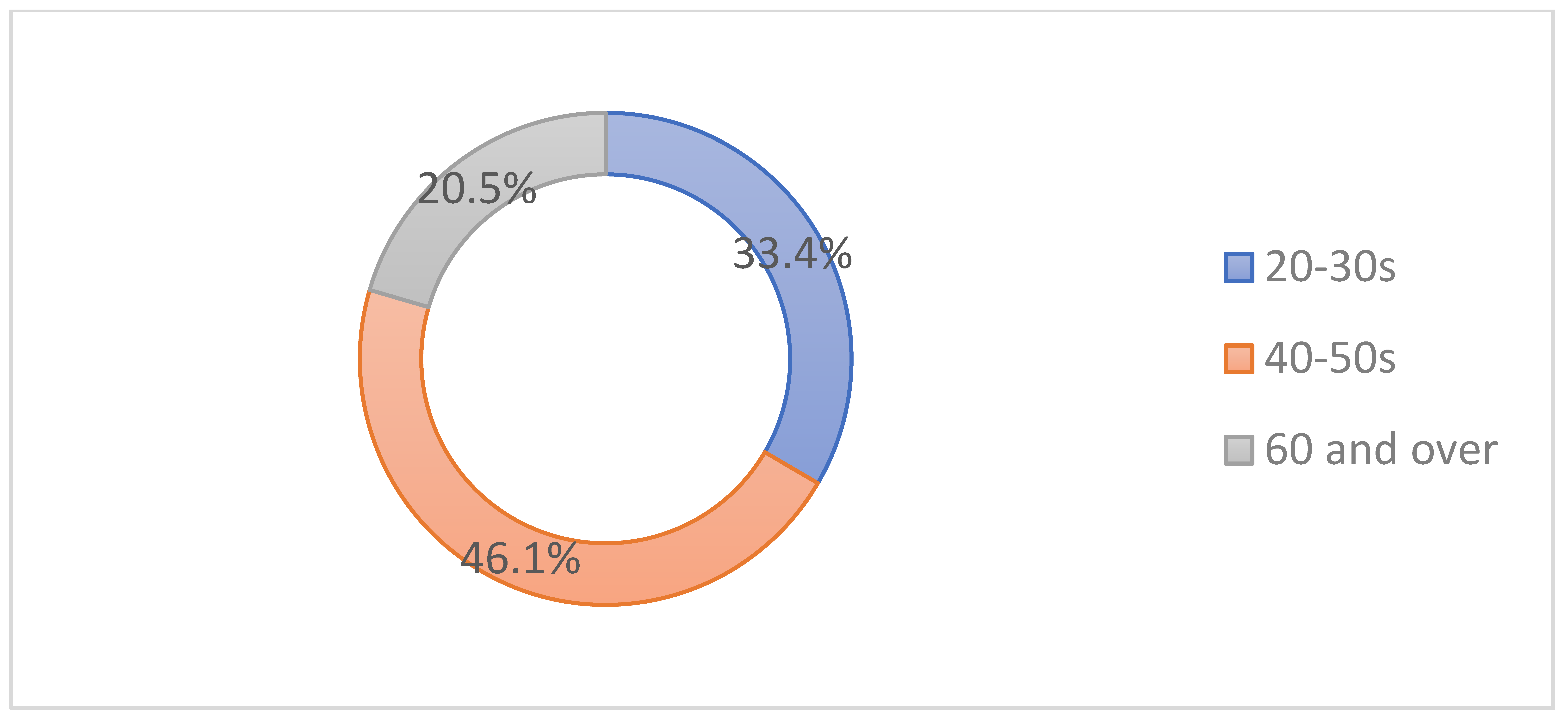
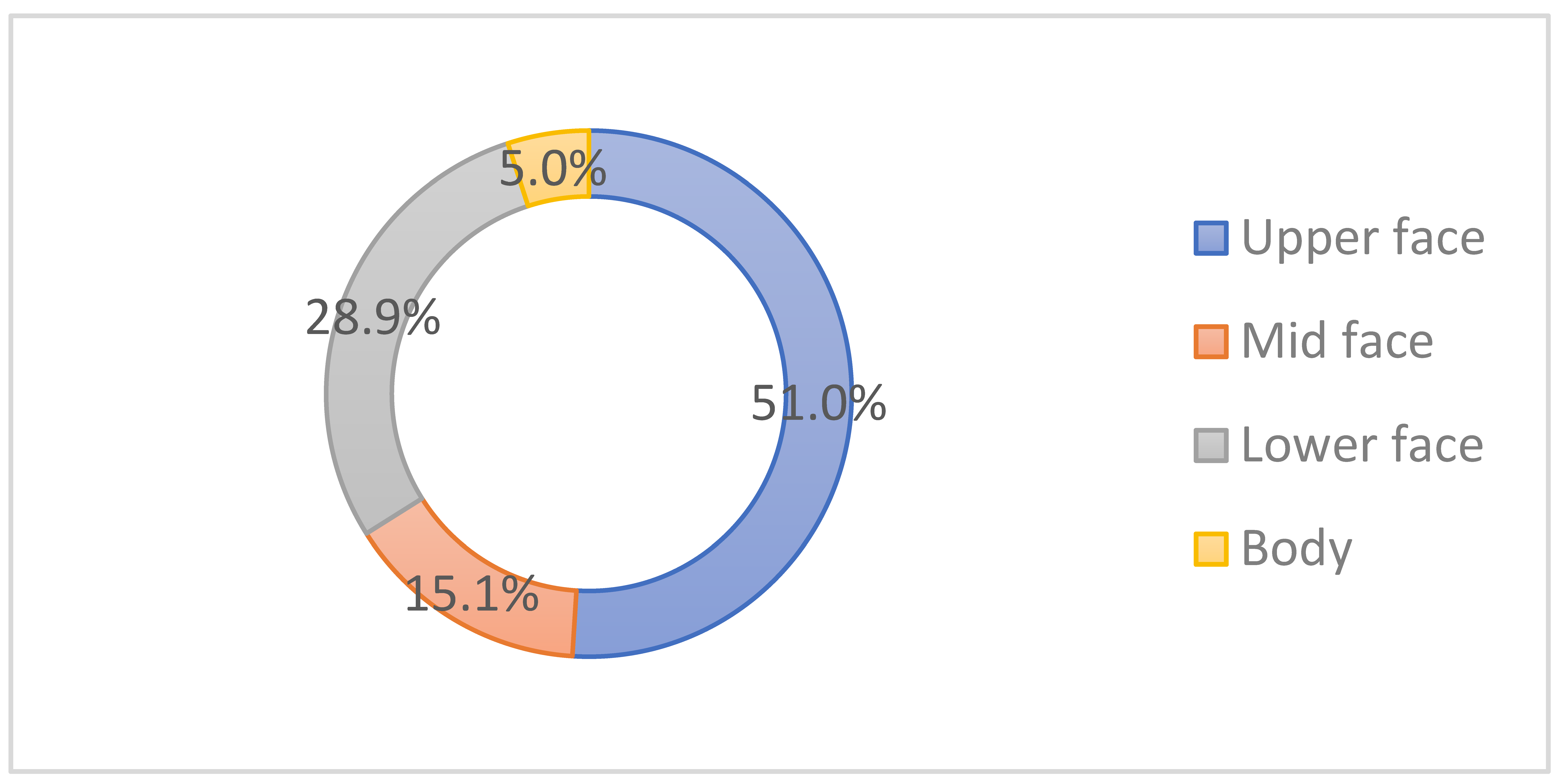
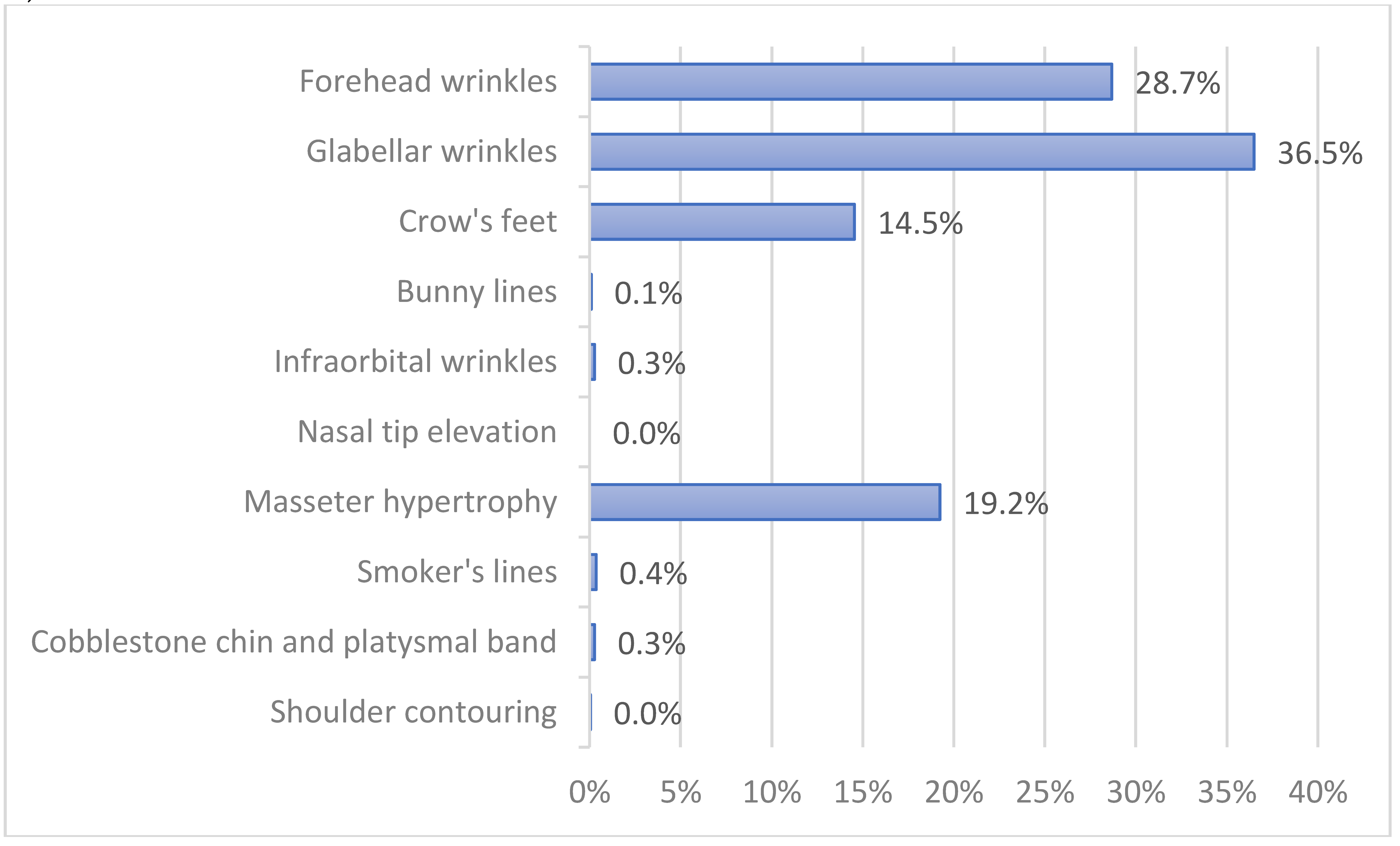
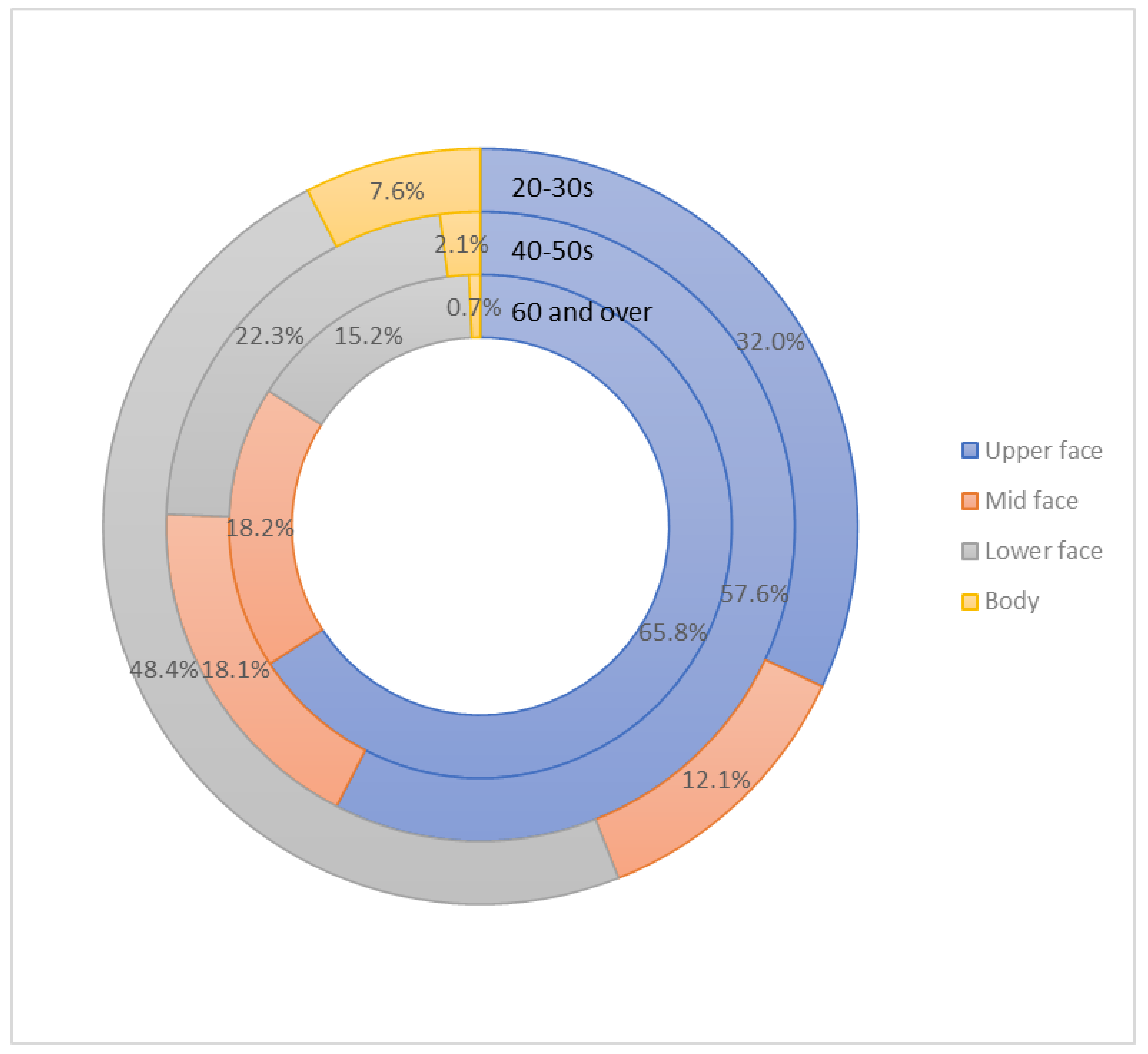
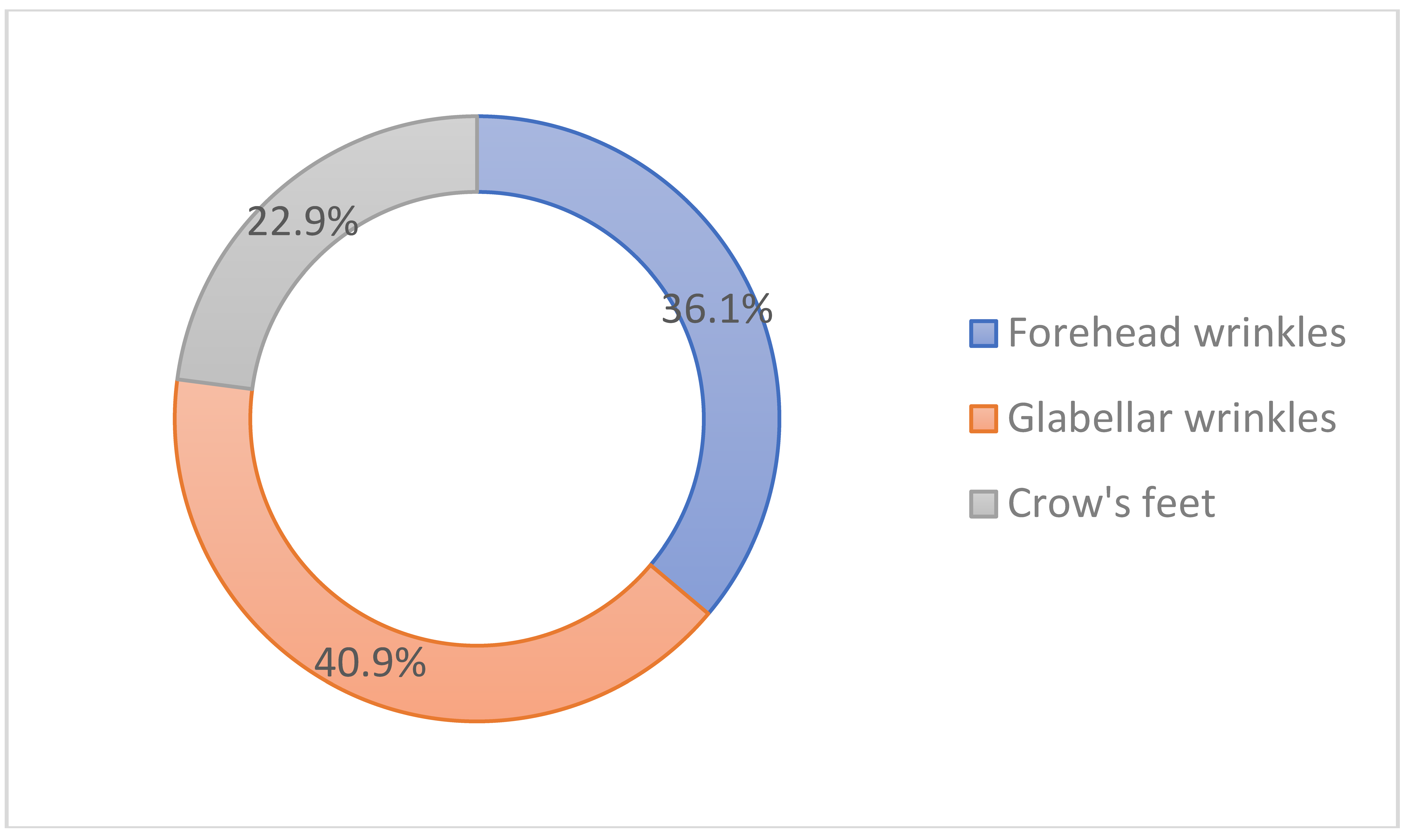
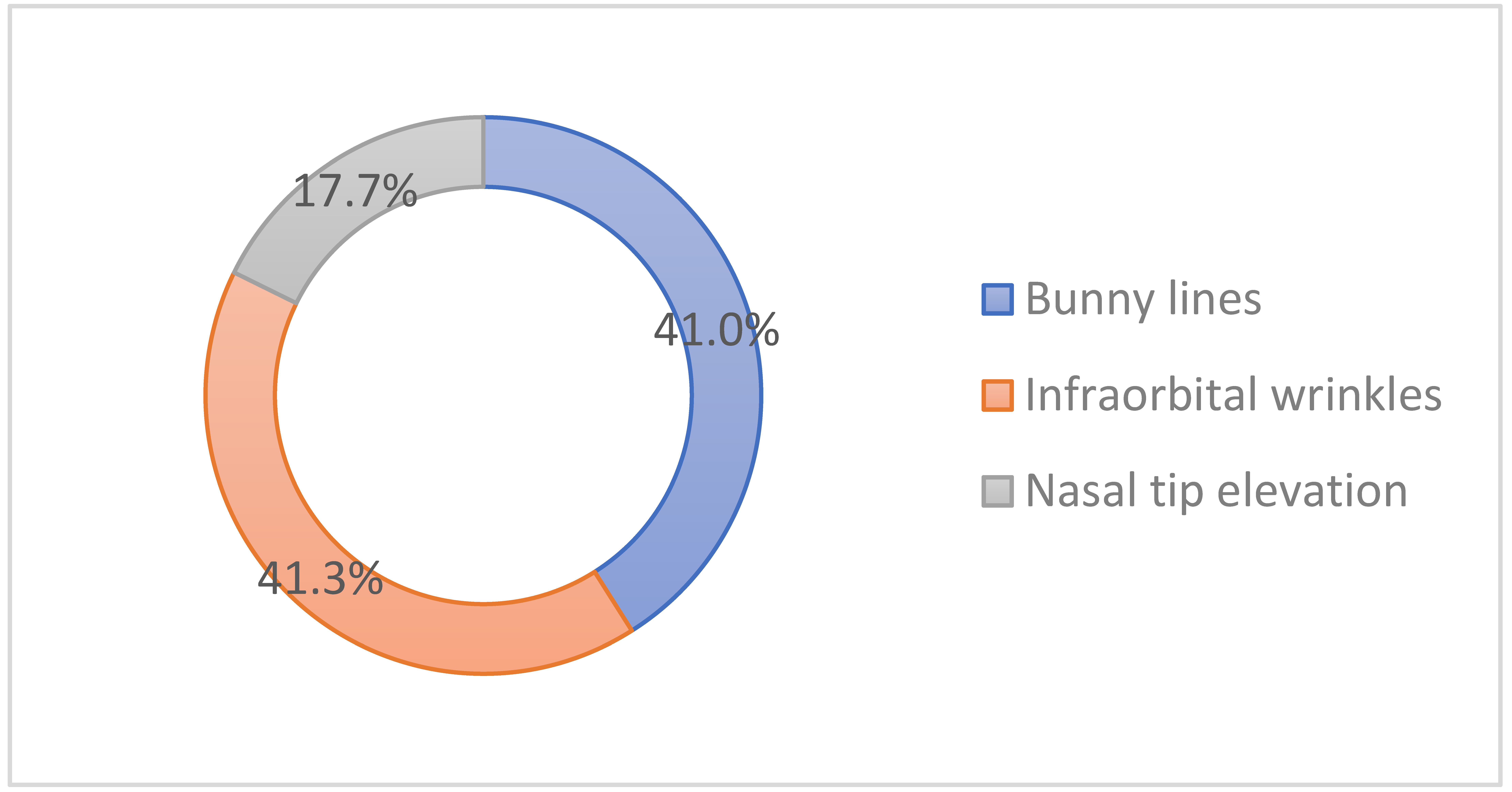

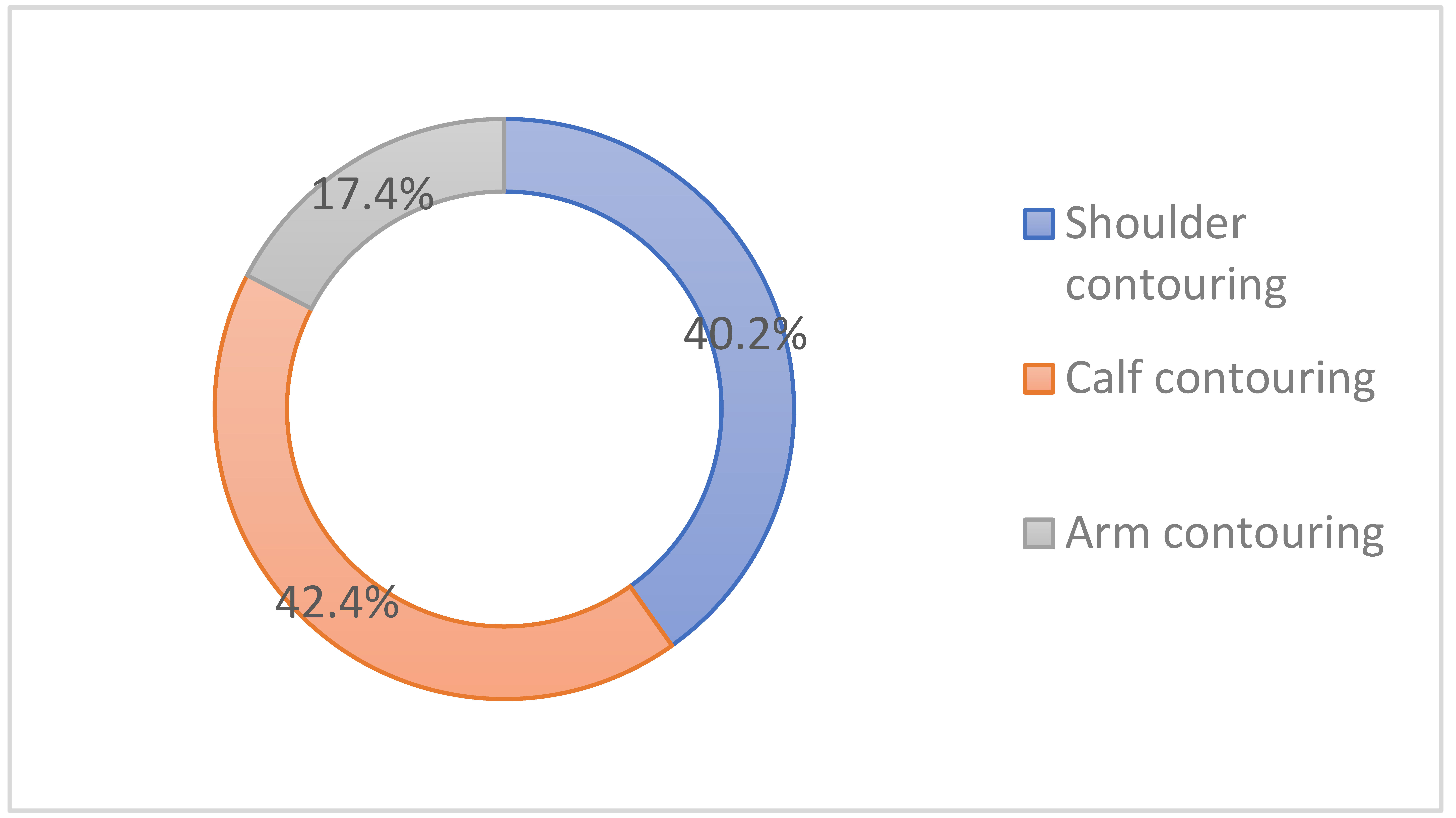
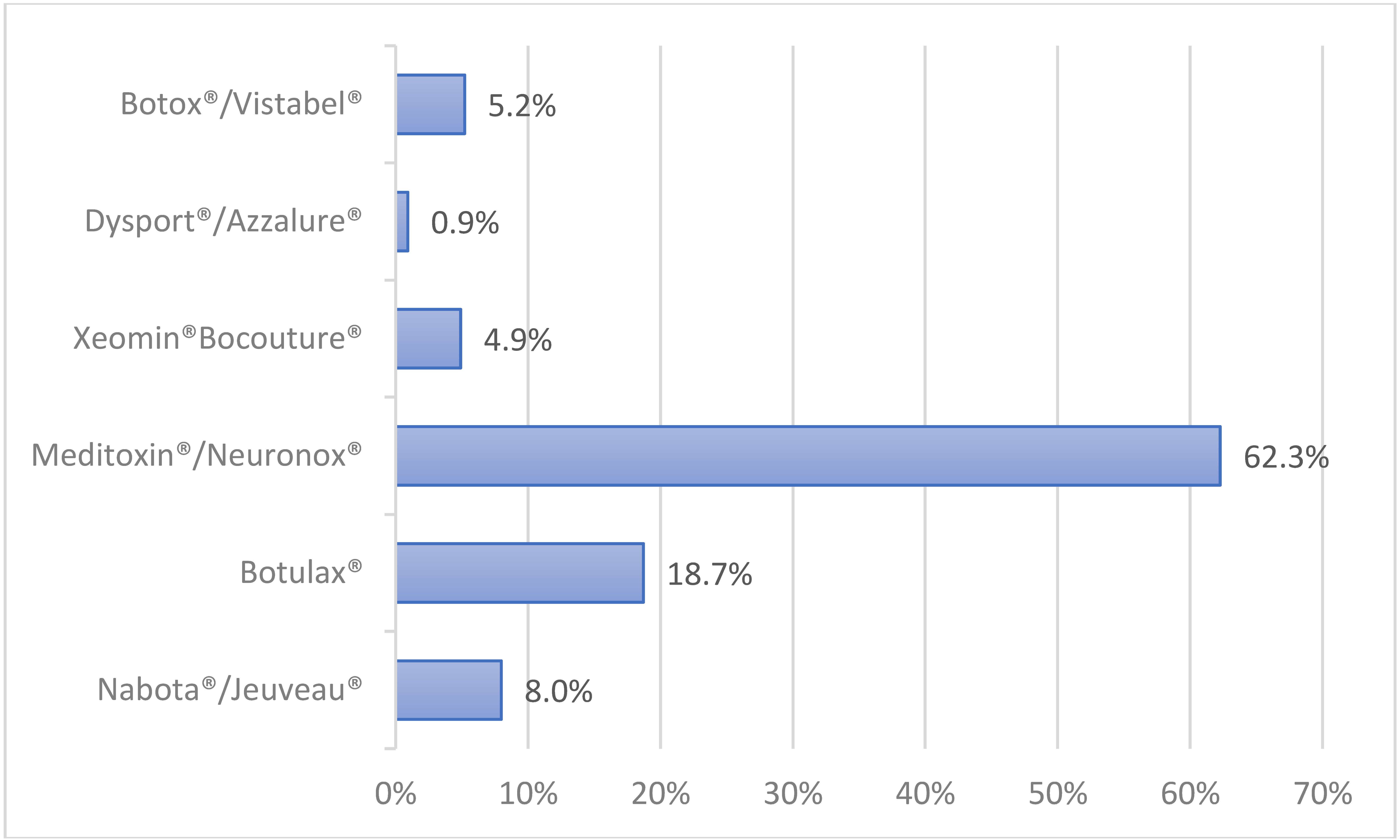
| Commercial Name | Manufacturer | Horizontal Forehead Dynamic Lines | Glabellar Dynamic Wrinkles | Lateral Canthal Dynamic Wrinkles |
|---|---|---|---|---|
| Botox®/Vistabel® | Allergan (U.S.A.) | □ | ■ | ■ |
| Botox®/Vistabel®50U | Allergan (U.S.A.) | □ | ■ | ■ |
| Botulax® | Hugel (Korea) | □ | ■ | ■ |
| Botulax®150U | Hugel (Korea) | □ | ■ | ■ |
| Botulax®200U | Hugel (Korea) | □ | ■ | ■ |
| Botulax®300U | Hugel (Korea) | □ | □ | □ |
| Botulax®50U | Hugel (Korea) | □ | ■ | ■ |
| BTX-A® | Lanzhou (China) | □ | □ | □ |
| Coretox® | Medy-Tox (Korea) | □ | ■ | □ |
| Dysport®/Azzalure® | Galderma (Switzerland) | □ | ■ | □ |
| Innotox® | Medy-Tox (Korea) | □ | ■ | □ |
| Liztox®100U | Huons (Korea) | □ | ■ | ■ |
| Liztox®200U | Huons (Korea) | □ | ■ | ■ |
| Liztox®50U | Huons (Korea) | □ | ■ | ■ |
| Meditoxin®/Neuronox® | Medy-Tox (Korea) | □ | ■ | ■ |
| Meditoxin®/Neuronox®150U | Medy-Tox (Korea) | □ | ■ | ■ |
| Meditoxin®/Neuronox®200U | Medy-Tox (Korea) | □ | ■ | ■ |
| Meditoxin®/Neuronox®50U | Medy-Tox (Korea) | □ | ■ | ■ |
| Nabota®/Jeuveau® | Daewoong (Korea) | □ | ■ | ■ |
| Nabota®/Jeuveau®150U | Daewoong (Korea) | □ | ■ | ■ |
| Nabota®/Jeuveau®200U | Daewoong (Korea) | □ | ■ | ■ |
| Nabota®/Jeuveau®25U | Daewoong (Korea) | □ | ■ | □ |
| Nabota®/Jeuveau®50U | Daewoong (Korea) | □ | ■ | ■ |
| Xeomin®/Bocouture® | Merz (Germany) | ■ | ■ | ■ |
| Xeomin®/Bocouture®50U | Merz (Germany) | ■ | ■ | ■ |
| Commercial Name | Manufacturer | Horizontal Forehead Dynamic Lines | Glabellar Dynamic Wrinkles | Lateral Canthal Dynamic Wrinkles |
|---|---|---|---|---|
| Bienox® | BNC Korea (Korea) | □ | ■ | □ |
| Hitox® | BMI Korea (Korea) | □ | ■ | □ |
| Inibo® | Inibio (Korea) | □ | ■ | □ |
| Jetema The Toxin®100U | Jetema (Korea) | □ | ■ | □ |
| Jetema The Toxin®200U | Jetema (Korea) | □ | ■ | □ |
| Protoxin®100U | Protox (Korea) | □ | ■ | □ |
| ReNTOX®100U | PharmaResearch (Korea) | □ | ■ | □ |
| Tyemvers® | Chong Kun Dang (Korea) | □ | ■ | □ |
| Off-Label Cosmetic Indications for BoNT-A Products |
| Bunny lines |
| Infraorbital wrinkles |
| Nasal tip elevation |
| Masseter hypertrophy |
| Smoker’s lines |
| Cobblestone chin and platysmal band |
| Shoulder contouring |
| Upper arm contouring |
| Calf contouring |
| Q1. | What is your practice setting? |
| □ | Private clinic |
| □ | Secondary or tertiary referral hospital |
| Q2 | How long have you been practicing botulinum toxin injections? |
| □ | Less than 1 year |
| □ | 1–5 years |
| □ | 5–10 years |
| □ | More than 10 years |
| Q3 | What is the approximate percentage of patients who visit your office for cosmetic procedures and for disease treatment? (the total should be 100) |
| □ | For cosmetic procedures: _______(%) |
| □ | For disease treatment: _______(%) |
| Q4 | What is the patient proportion, by age (years), of those who visit for cosmetic procedures? (total should be 100) |
| □ | 20–30 years: _______(%) |
| □ | 40–50 years: _______(%) |
| □ | 60 and over: _______(%) |
| Q5 | Among those who receive cosmetic botulinum toxin injections, what is the treatment rate by site? (total should be 100) |
| □ | Upper face: _______(%) |
| □ | Midface: _______(%) |
| □ | Lower face/neck: _______(%) |
| □ | Body (trunk or extremities): _______(%) |
| Q6 | What are the three most frequent indications among patients who receive cosmetic botulinum toxin injections? |
| □ | Forehead wrinkles |
| □ | Glabellar wrinkles |
| □ | Crow’s feet |
| □ | Bunny lines |
| □ | Infraorbital wrinkles |
| □ | Nasal tip elevation |
| □ | Masseter hypertrophy |
| □ | Smoker’s lines |
| □ | Cobblestone chin and platysmal band |
| □ | Shoulder contouring (Trapezius muscle injection) |
| □ | 1st: _________________________ |
| □ | 2nd: _________________________ |
| □ | 3rd: __________________________ |
| Q7 | Among those in their 20–30 years who receive cosmetic botulinum toxin injections, what is the rate of the procedure by site? (total should be 100) |
| □ | Upper face: _______(%) |
| □ | Mid face: _______(%) |
| □ | Lower face/neck: _______(%) |
| □ | Body: _______(%) |
| Q8 | Among those in their 40–50 years who receive cosmetic botulinum toxin injections, what is the rate of the procedure by site?(total should be 100) |
| □ | Upper face: _______(%) |
| □ | Mid face: _______(%) |
| □ | Lower face/neck: _______(%) |
| □ | Body: _______(%) |
| Q9 | Among the patients aged 60 years and older who receive cosmetic botulinum toxin injections, what is the rate of the procedure by site? (total should be 100) |
| □ | Upper face: _______(%) |
| □ | Mid face: _______(%) |
| □ | Lower face/neck: _______(%) |
| □ | Body: _______(%) |
| Q10 | Please rank the following indications based on their popularity among patients who receive cosmetic botulinum toxin injections in the upper face. |
| □ | Forehead wrinkles |
| □ | Glabellar wrinkles |
| □ | Periorbital wrinkles (“crow’s feet lines”) |
| □ | 1st: _________________________ |
| □ | 2nd: _________________________ |
| □ | 3rd: __________________________ |
| Q11 | Please rank the following indications based on their popularity among patients who receive cosmetic botulinum toxin injections in the midface. |
| Nasal wrinkles (“bunny lines”) | |
| □ | Infraorbital wrinkles |
| □ | Drooping nasal tip |
| □ | 1st: _________________________ |
| □ | 2nd: _________________________ |
| □ | 3rd: __________________________ |
| Q12 | Please rank the following indications based on their popularity among patients who receive cosmetic botulinum toxin injections in the lower face/neck. |
| □ | Masseter hypertrophy |
| □ | Vertical perioral wrinkles (“smoker’s lines”) |
| □ | Chin creases (“cobblestone chin”) |
| □ | Platysmal bands |
| □ | 1st: _________________________ |
| □ | 2nd: _________________________ |
| □ | 3rd: __________________________ |
| Q13 | Please rank the following indications based on their popularity among patients who receive cosmetic botulinum toxin injections in the body (trunk or extremities). |
| □ | Shoulder contouring |
| □ | Calf contouring |
| □ | Upper arm contouring |
| □ | 1st: _________________________ |
| □ | 2nd: _________________________ |
| □ | 3rd: __________________________ |
| Q14 | When reconstituting a botulinum toxin product for wrinkle effacement, what amount of isotonic saline do you add for 100 units of type A botulinum toxin? |
| □ | 1 mL |
| □ | 2 mL |
| □ | 2.5 mL |
| □ | 4 mL |
| □ | 5 mL |
| Q15 | Have you experienced cases suspicious of clinical resistance to botulinum toxin treatment? |
| □ | No |
| □ | Yes |
| Q16 | What is your routine treatment interval for botulinum toxin injections? |
| □ | 2 months (or less) |
| □ | 3 months |
| □ | 4 months |
| □ | 5 months |
| □ | 6 months (or more) |
| Q17 | What factor do you consider the most in choosing a botulinum toxin product? |
| □ | Low price |
| □ | Liquid formulation (pre-reconstituted botulinum toxin) |
| □ | Low risk of antibody formation (low risk of clinical resistance) |
| □ | Reliability (stability-constant potency, therapeutic efficacy) |
| Q18 | What commercial product do you use the most? |
| □ | Botox® Vistabel® (Allergan, USA) |
| □ | Dysport®/Azzalure® (Galderma, Switzerland) |
| □ | Xeomin®/ Bocouture® (Merz, Germany) |
| □ | Meditoxin®/Neuronox® (Medy-Tox, Korea) |
| □ | Botulax® (Hugel, Seoul, Korea) |
| □ | Nabota®/Jeuveau® (Daewoong, Korea) |
Publisher’s Note: MDPI stays neutral with regard to jurisdictional claims in published maps and institutional affiliations. |
© 2022 by the authors. Licensee MDPI, Basel, Switzerland. This article is an open access article distributed under the terms and conditions of the Creative Commons Attribution (CC BY) license (https://creativecommons.org/licenses/by/4.0/).
Share and Cite
Rho, N.-K.; Han, K.-H.; Kim, H.-S. An Update on the Cosmetic Use of Botulinum Toxin: The Pattern of Practice among Korean Dermatologists. Toxins 2022, 14, 329. https://doi.org/10.3390/toxins14050329
Rho N-K, Han K-H, Kim H-S. An Update on the Cosmetic Use of Botulinum Toxin: The Pattern of Practice among Korean Dermatologists. Toxins. 2022; 14(5):329. https://doi.org/10.3390/toxins14050329
Chicago/Turabian StyleRho, Nark-Kyoung, Kwang-Ho Han, and Hei-Sung Kim. 2022. "An Update on the Cosmetic Use of Botulinum Toxin: The Pattern of Practice among Korean Dermatologists" Toxins 14, no. 5: 329. https://doi.org/10.3390/toxins14050329
APA StyleRho, N.-K., Han, K.-H., & Kim, H.-S. (2022). An Update on the Cosmetic Use of Botulinum Toxin: The Pattern of Practice among Korean Dermatologists. Toxins, 14(5), 329. https://doi.org/10.3390/toxins14050329







